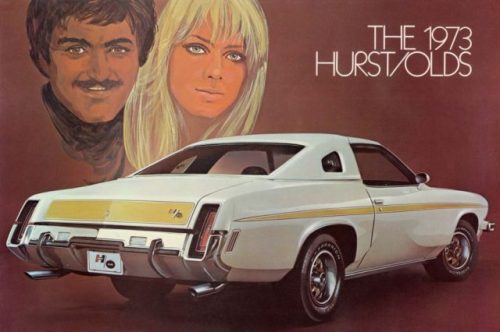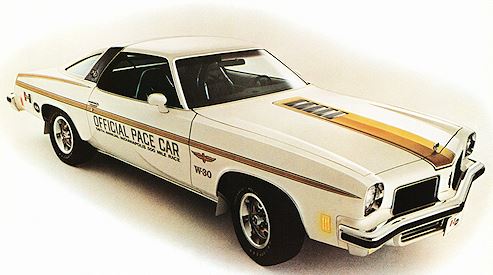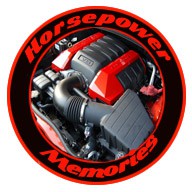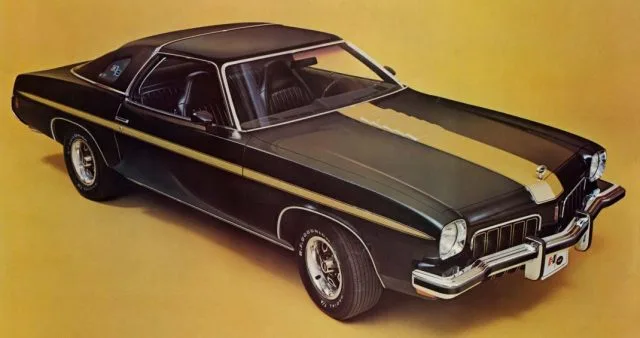The Hurst Olds Story, Part Two
The Hurst Olds, as well as the entire GM A-body lineup, went through a major transformation for the 1973 model year. Based on the new Colonnade body style, the new Hurst Olds featured a unique B-pillar roofline, frameless side windows, and rear quarter windows. And even though 1973 model matched the previous year’s 112-inch wheelbase, the new Hurst Olds was just over 300 pounds heavier and 3.4 inches longer than the 1972 model.
1973: For the Man in Motion
The 1973 Hurst Olds was based on the Oldsmobile Cutlass S semi-fastback. For the first time since its inception, the Hurst Olds was available in two color schemes. Buyers could choose between Cameo White or Ebony Black paint with Hurst custom gold body accents. The 1973 Hurst Olds featured a padded vinyl landau half roof, opera windows with Mylar-etched “H/O” badging, and non-functional, rear-facing hood louvers. The new Hurst Olds also featured chrome tail pipes, body-colored sport mirrors, and black-accented grille and taillamp bezels. B.F. Goodrich Lifesaver tires with GR60 x 14 Super Stock III wheels in Hurst Gold or Ebony Black and an Oldsmobile scripted hood ornament round out this sport coupe’s exterior features. The new Colonnade Hurst Olds featured the federally mandated 5-mph front bumper and 2.5-mph rear bumper.
Inside, drivers are greeted by Strato-bucket swivel seats, a center console, and, of course, the Hurst Dual/Gate shifter. This unique shifter operates by giving drivers a choice of standard automatic transmission shift control or driver control over gear shifts. The shifter worked by placing the transmission in the “Drive” position and then moving the shifter through a spring-loaded gate then down. An option of interest was the Hurst Digital Tachometer. It reads out RPMs in hundreds of revolutions per minute, constantly displays engine RPM, and can store the highest RPM logged. This tachometer also features a memory system that can save the RPM recorded, which can be shown on command and be reset when needed.

The sole powerplant offered, with two different outputs, was a 455 cubic-inch V8. The 455 L75 Performance Engine had an output of 270 horsepower. This engine gained standard performance equipment such as Rallye suspension, power disc brakes, and dual exhaust. However, one option not available with the L75 was air conditioning. The 455 L77 Performance Engine cranked out 250 horsepower. This engine came equipped with a special camshaft, a transmission with a high-speed torque converter, and 3.08 rear axle ratio. Air conditioning was available with this engine. The Turbo Hydramatic 400 three-speed automatic was the only transmission available for both engines.
Hurst Performance touted a 0 to 60 time of 6.5 seconds. That’s pretty respectable for a two-ton car. That time is comparable to the 1972 Hurst Olds, which could sprint from 0 to 60 in 6.8 seconds.
1,097 Hurst Olds were produced for the 1973 model year.
1974: Changes and Choices

The Hurst Olds returned for 1974 with a slightly refreshed fascia and roof, two engine choices, and drivers could choose a black or white interior color. It was still based on the Oldsmobile Cutlass S model. The 1974 Hurst Olds was still available in Cameo White or Ebony Black.
The Hurst Olds was chosen for a second time to pace the Indianapolis 500. This decision also brought changes to the Hurst Olds’ exterior. Since the Colonnade era Hurst Olds was not available as a convertible, actual Indy 500 pace cars featured removable roof glass and a padded rollbar. In order to mimic this look on the street version, a panel that diminished the size of the quarter glass and a replicated roll bar was created with the vinyl top and special stainless trim. The mocked-up rollbar portion of the top came in white on black cars and black on white cars.
The 1974 Hurst Olds was available with two engine configurations. The W30 came equipped with the L76 455 cubic-inch V8 engine with 230 horsepower. This engine came mated to a Turbo Hydra-matic 400 three-speed automatic transmission. The L76 455 featured a dual snorkel air breather, Rochester Quadrajet four-barrel carburetor, and low restriction dual exhaust. The W30 version also came equipped with 15-inch gold wheels, Hurst Dual/Gate shifter, and H/O emblem on the interior console. This engine was not available in California.
The W25 came equipped with the L34 350 cubic-inch V8 with 180 horsepower. This engine came standard with the Turbo Hydra-matic 350 three-speed automatic transmission. The L34 featured a Rochester Quadrajet four-barrel carburetor, single exhaust system, and standard Oldsmobile column shifter. The W25 also came with 14-inch wheels and no H/O emblem on the console. Also, the W25 was the only version of the Hurst Olds available in California.
The 1974 Hurst Olds W30 could run from 0 to 60 in 8.3 seconds and sprint the quarter mile in 16.2 seconds.
1,800 Hurst Olds were built for the 1974 model year. 1,420 of those were powered by the W25 350 cubic-inch engine and 380 cars found the W30 455 cubic-inch engine under the hood.
1975: Stickered and Stymied

The 1975 model year would see the Hurst Olds based on the Cutlass Supreme. The Hurst Olds package added $1,095 to the price of the Cutlass Supreme. Features of the 1975 Hurst Olds include a Cutlass Salon grille, 442-style louvered hood, and sports styled mirrors. The package also comprised of Super Stock III wheels, 15-inch raised white letter radial tires, and Cameo White or Ebony Black paint. Once again, the interior was available in either black or white.
The 1975 Hurst Olds was no stranger to change. New for 1975 was a federal mandated 5-mph rear bumper. Also, catalytic converters were now a requirement for all cars sold in the U.S. While they helped clean the air, they significantly choked performance. With the addition of catalytic converters, all Hurst Olds now received a single exhaust system, opposed to the dual exhaust system from previous years.
The 1975 Hurst Olds was the first GM car to be equipped with the Hurst/Hatch T-tops. These removable roof panels featured smoke-tinted safety glass with silver aluminum frames.
The good news is buyers could still choose between the W25 350 cubic-inch and the W30 455 cubic-inch engines. The bad news is horsepower was done significantly. The W25 could only muster 170 horsepower and 275 lb.-ft of torque. The W30 only generated a wheezy 190 horsepower and 350 lb.-ft. of torque.
A sign of the times, the once mighty W30 could only run from 0 to 60 in a measly 10.5 seconds and dash the quarter mile in 17.7 seconds at 81 miles per hour.
Even with diminishing performance, the 1975 Hurst Olds sold its greatest numbers. 2,535 Hurst Olds were sold for the 1975 model year. It should also be noted that the 1975 Hurst Olds was the first to surpass 2,000 units sold. By now, the Hurst Olds could be considered more of a personal luxury car than a muscle car.
The Colonnade era Hurst Olds may not get the respect of its predecessors, but it’s still worth checking out. Even with waning performance, the 1973-1975 Hurst Olds was still an alternative to those desiring something other than a Camaro or Mustang II. And with low production numbers, seeing a 1973-1975 Hurst Olds today is a rare treat. You might get lucky and catch one at your next car show or cruise-in.


Leave a comment